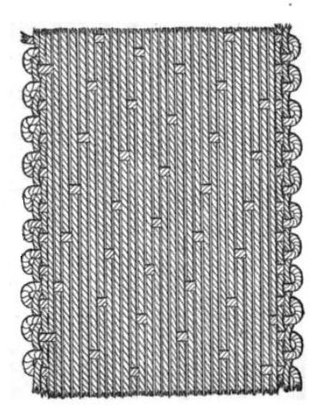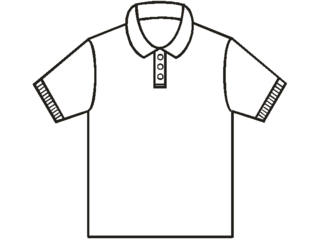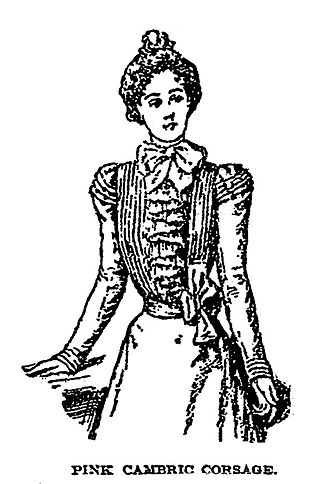
Oxford cloth is a type of woven dress shirt fabric, employed to make dress shirts sometimes called Oxford shirts worn on casual to formal occasions.

Oxford cloth is a type of woven dress shirt fabric, employed to make dress shirts sometimes called Oxford shirts worn on casual to formal occasions.
Oxford cloth has a basket-weave structure and a lustrous aspect [1] making it a popular fabric for dress shirts. [2]
Plain Oxford and Pinpoint Oxford are commonly used for casual shirt designs such as a button-down collar. Pinpoint Oxford is made from finer yarn and has a tighter weave than plain Oxford. It shows a "pin" or "dot" effect in the texture. [3] Royal Oxford is considered a more formal option. It is suited to business or sporty dress codes. [4]

The kimono is a traditional Japanese garment and the national dress of Japan. The kimono is a wrapped-front garment with square sleeves and a rectangular body, and is worn left side wrapped over right, unless the wearer is deceased. The kimono is traditionally worn with a broad sash, called an obi, and is commonly worn with accessories such as zōri sandals and tabi socks.

A kilt is a garment resembling a wrap-around knee-length skirt, made of twill woven worsted wool with heavy pleats at the sides and back and traditionally a tartan pattern. Originating in the Scottish Highland dress for men, it is first recorded in 16th century as the great kilt, a full-length garment whose upper half could be worn as a cloak. The small kilt or modern kilt emerged in the 18th century, and is essentially the bottom half of the great kilt. Since the 19th century, it has become associated with the wider culture of Scotland, and more broadly with Gaelic or Celtic heritage.

A shirt is a cloth garment for the upper body.

A satin weave is a type of fabric weave that produces a characteristically glossy, smooth or lustrous material, typically with a glossy top surface and a dull back; it is not durable, as it tends to snag. It is one of three fundamental types of textile weaves alongside plain weave and twill weave.

A suit, lounge suit, or business suit is a set of clothes comprising a suit jacket and trousers of identical textiles worn with a collared dress shirt, necktie, and dress shoes. A skirt suit is similar, but with a matching skirt instead of trousers. It is considered informal wear in Western dress codes. The lounge suit originated in 19th-century Britain as a more casual alternative for sportswear and British country clothing, with roots in early modern Western Europe. After replacing the black frock coat in the early 20th century as regular daywear, a sober one-colored suit became known as a lounge suit.

Poplin, also called tabinet, is a fine wool, cotton or silk fabric that has a vertical warp and a horizontal weft. Nowadays, the name refers to a strong material in a plain weave of any fiber or blend, with crosswise ribs that typically give a corded surface.

The dhoti, also known as veshti, mardani, chaadra, dhontar, jaiñboh & panchey, is a type of sarong, fastened in between the legs in a manner that it outwardly resembles trousers, sometimes loose but other tighter fittings are worn as well. It is a lower garment forming part of the ethnic costume for men in the Indian subcontinent. The dhoti is fashioned out of a rectangular piece of unstitched cloth, usually around 4.5 metres (15 ft) long, wrapped around the waist and the legs and knotted, either in the front or the back.
Lawn cloth or lawn is a fine plain weave textile, made with fine combed cotton. Terms also used include batiste and nainsook. Originally the name applied to plain weave linen, and linen lawn is also called "handkerchief linen". The term lawn is also used in the textile industry to refer to a type of starched crisp finish given to a cloth product. The finish can be applied to a variety of fine fabrics, prints or plain.
Clothing in India is dependent upon the different ethnicities, geography, climate, and cultural traditions of the people of each region of India. Historically, male and female clothing has evolved from simple garments like kaupina, langota, achkan, lungi, sari, well as rituals and dance performances. In urban areas, western clothing is common and uniformly worn by people of all social levels. India also has a great diversity in terms of weaves, fibers, colours, and material of clothing. Sometimes, color codes are followed in clothing based on the religion and ritual concerned. The clothing in India also encompasses the wide variety of Indian embroidery, prints, handwork, embellishment, styles of wearing clothes. A wide mix of Indian traditional clothing and western styles can be seen in India.

Flannel is a soft woven fabric, of various fineness. Flannel was originally made from carded wool or worsted yarn, but is now often made from either wool, cotton, or synthetic fiber. Flannel is commonly used to make tartan clothing, blankets, bed sheets, and sleepwear.

A polo shirt, tennis shirt, golf shirt, or chukker shirt is a form of shirt with a collar. Polo shirts are usually short sleeved but can be long; they were used by polo players originally in India in 1859 and in Great Britain during the 1920s.

Cambric or batiste is a fine dense cloth. It is a lightweight plain-weave fabric, originally from the commune of Cambrai, woven greige, then bleached, piece-dyed, and often glazed or calendered. Initially it was made of linen; from the 18th and 19th centuries the term came to apply to cotton fabrics as well. Chambray is the same type of fabric, with a coloured warp and white filling; the name "chambray" replaced "cambric" in the United States in the early 19th century.

Piqué, or marcella, refers to a weaving style, normally used with cotton yarn, which is characterized by raised parallel cords or geometric designs in the fabric. Piqué fabrics vary from semi-sheer dimity to heavy weight waffle cloth. Twilled cotton and corded cotton are close relatives.

A dress shirt, button shirt, button-front, button-front shirt, or button-up shirt, is a garment with a collar and a full-length opening at the front, which is fastened using buttons or shirt studs. A button-down or button-down shirt is a dress shirt with a button-down collar – a collar having the ends fastened to the shirt with buttons.

Smart casual is an ambiguously defined Western dress code that is generally considered casual wear but with smart components of a proper lounge suit from traditional informal wear. For men, this interpretation typically includes dress shirt, necktie, trousers, and dress shoes, possibly worn with an odd-coloured blazer or a sports coat.
The formal Thai national costume, known in Thai as ชุดไทยพระราชนิยม, includes several sets of clothing, or chut thai, designed for use as national costume on formal occasions. Although described and intended for use as national costume, they are of relatively modern origins, having been conceived in the second half of the twentieth century.

Bands are a form of formal neckwear, worn by some clergy and lawyers, and with some forms of academic dress. They take the form of two oblong pieces of cloth, usually though not invariably white, which are tied to the neck. When worn by clergy, they typically are attached to a clerical collar. The word bands is usually plural because they require two similar parts and did not come as one piece of cloth. Those worn by clergy are often called preaching bands or Geneva bands; those worn by lawyers are called barrister's bands or, more usually in Ireland and Canada, tabs. Preaching bands symbolize the two tablets of the Ten Commandments given by God to Moses.

Ivy League is a style of men's dress, popular during the late 1950s in the Northeastern United States, and said to have originated on college campuses, particularly those of the Ivy League. It was the predecessor to the preppy style of dress.

Herringbone, also called broken twill weave, describes a distinctive V-shaped weaving pattern usually found in twill fabric. It is distinguished from a plain chevron by the break at reversal, which makes it resemble a broken zigzag. The pattern is called herringbone because it resembles the skeleton of a herring fish. Herringbone-patterned fabric is usually wool, and is one of the most popular cloths used for suits and outerwear. Tweed cloth is often woven with a herringbone pattern.

The national costume of Indonesia is the national costume that represents the Republic of Indonesia. It is derived from Indonesian culture and Indonesian traditional textile traditions. Today the most widely recognized Indonesian national costumes include batik and kebaya, although originally those costumes mainly belong within the island of Java and Bali, most prominently within Javanese, Sundanese and Balinese culture. Since Java has been the political and population center of Indonesia, folk costume from the island has become elevated into national status.